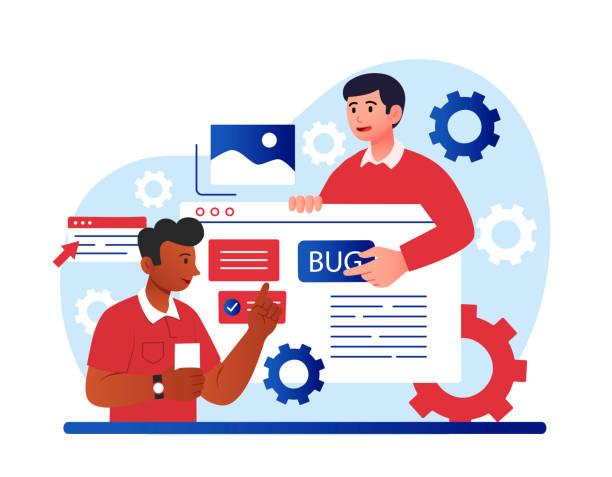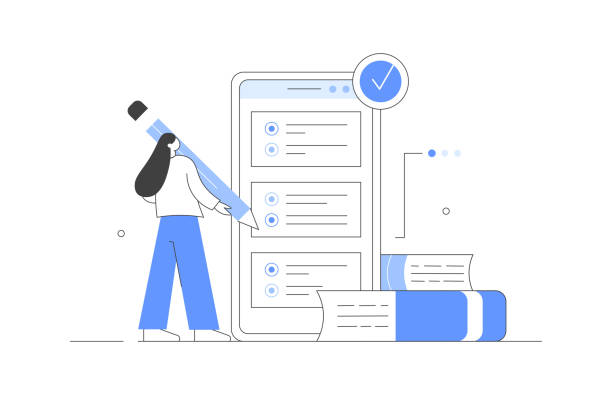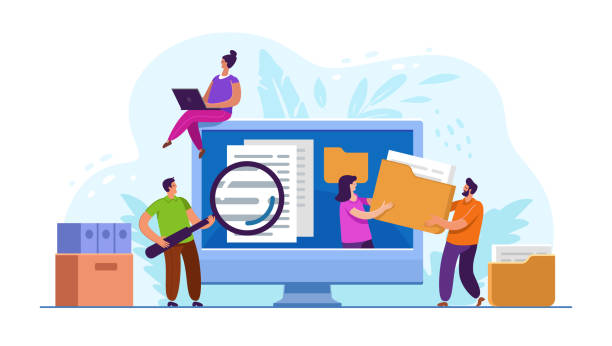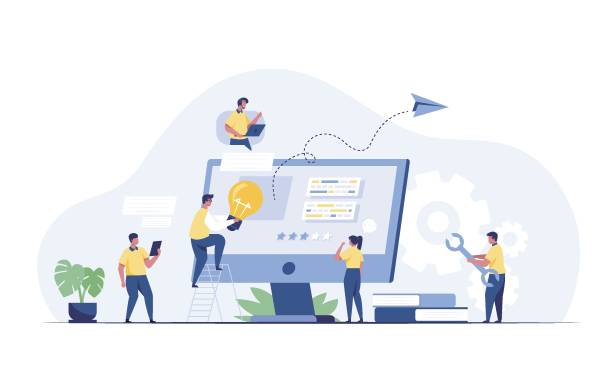The Importance of Secure Website Design in the Digital Age

In today’s world where digital and physical boundaries are intertwined, secure website design is no longer an option, but a vital necessity.
With the increasing growth of online businesses, the importance of #data_protection and #cybersecurity has become more apparent than ever.
Every website, from a simple personal blog to large e-commerce platforms, is a potential target for cyber attacks.
These attacks can lead to the theft of sensitive user data, loss of brand reputation, significant financial damages, and even legal issues.
Imagine a banking platform whose customer information is exposed due to security vulnerabilities; an absolute disaster.
Therefore, any investment in secure website design is, in fact, an investment in the sustainability and future of your business.
This descriptive approach not only helps protect user data but also builds their trust and ensures long-term brand loyalty.
A deep understanding of the importance of website security in this digital age is the first step towards creating a trustworthy and stable online environment.
Without adhering to basic security principles, even the best business ideas can fall victim to cyber threats.
Does losing customers who have visited your site to make a purchase bother you?
Rasaweb is your specialized solution for having a successful online store.
✅ Significantly increase your online sales
✅ Build trust and professional branding among customers⚡ Get free consultation from Rasaweb experts!
Common Web Security Threats and Countermeasures

To achieve secure website design, understanding #common_web_threats and how they operate is essential.
One of the most common attacks is SQL injection, where an attacker inserts malicious code into input fields to manipulate or gain unauthorized access to the database.
The solution to counter it is meticulous input validation and the use of Prepared Statements.
Another attack is Cross-Site Scripting (XSS), where malicious JavaScript code is executed in the victim’s browser, which can lead to the theft of cookies or session information.
To counter XSS, filtering and sanitizing all user inputs before display is essential.
Also, DDoS attacks aim to disable the server by sending a massive volume of requests, for which the use of Web Application Firewalls (WAF) and DDoS protection services is recommended.
This educational and specialized section helps you take more effective steps towards secure web development by correctly understanding these vulnerabilities and preventing serious problems in the future.
Accurate knowledge of these threats and the implementation of preventive solutions are considered the backbone of any secure website design project.
Basic Principles and Secure Architecture in Website Design

Building a secure website design begins from the very first stages of #web_architecture.
The most important principle is the “Security by Design” approach; meaning security should not be added as an extra feature at the end of the project, but rather integrated into all stages of the #Software_Development_Life_Cycle (SDLC).
Using web development frameworks that inherently consider security (such as Django, Laravel, ASP.NET Core) can greatly assist in this.
Furthermore, precise and complete validation of all user inputs (Input Validation) is a crucial step to prevent the entry of malicious data.
Proper error handling (Error Handling) is also important; application errors should not disclose sensitive information to attackers.
Additionally, using security design patterns (Security Design Patterns) like the Prevent SQL Injection pattern or the Anti-XSS pattern helps developers write stronger and safer code.
This guiding and specialized section demonstrates how a secure web structure provides the foundation for your site’s long-term stability and protection.
This table summarizes some key principles of secure architecture:
| Security Principle | Description |
|---|---|
| Least Privilege | Grant users and systems only the minimum necessary access to perform their tasks. |
| Defense in Depth | Implement multiple layers of security to protect resources. |
| Never Trust User Input | Validate and sanitize all user input data before use. |
| Security by Default | Default system settings should be secure, requiring no manual changes. |
These principles are fundamental to any successful secure web development strategy and help ensure your site is resilient against threats from the outset.
The Role of SSL/TLS and Security Protocols in Data Protection

One of the most important pillars of secure website design is the use of encryption protocols.
#SSL and #TLS (Secure Sockets Layer/Transport Layer Security) are technologies that encrypt the communication between the user’s browser and the web server.
This encryption ensures that all exchanged information, including login credentials, credit card numbers, and personal data, remains safe from unauthorized access.
When a site uses HTTPS (Hypertext Transfer Protocol Secure), it means its communications are secured by SSL/TLS.
This is not only vital for user privacy but also a significant factor for #user_trust and even website SEO.
Google and other search engines give a better ranking to sites that use HTTPS.
This descriptive and specialized section introduces the importance of SSL/TLS certificates beyond a technical requirement, considering it a strategic tool for maintaining site security and increasing brand credibility.
Proper installation and keeping these certificates up-to-date is a fundamental step towards creating a secure and reliable website.
Without this protective layer, data is transmitted as plain text and can be easily intercepted and misused by attackers.
Are you tired of losing business opportunities due to not having a professional corporate website?
Rasaweb, with its professional corporate website design, helps you:
✅ Build a powerful and reliable image for your brand
✅ Convert website visitors into loyal customers⚡ Get free consultation now!
Database Management and Strong Authentication

The beating heart of any website is its #database, and secure website design makes no sense without attention to database security.
To protect sensitive data, it’s essential to first ensure data encryption at rest (Encryption at Rest) and in transit (Encryption in Transit).
Also, restricting access to the database, so that only necessary modules have access, is crucial.
Using strong and unique passwords for database accounts and regularly changing them are other important measures.
In terms of #authentication, implementing strong mechanisms like Multi-Factor Authentication (MFA) for users and administrators provides a powerful security layer.
This specialized and educational section emphasizes the importance of strong password policies, including complexity, appropriate length, and periodic expiration.
Preventing the storage of passwords in plain text and using strong hashing functions (such as bcrypt or Argon2) to store them in the database are fundamental principles.
Additionally, implementing CAPTCHA to prevent Brute Force attacks and using Intrusion Detection Systems (IDS) can help identify and prevent unauthorized login attempts.
These collective measures provide a foundation for creating a secure website and protecting confidential information.
Continuous Updates and Security Monitoring

A crucial aspect of secure website design that is often overlooked is #continuous_updates and #security_monitoring.
Security is not a static process, but a continuous effort.
Attackers are constantly discovering new vulnerabilities in software, plugins, frameworks, and operating systems.
Therefore, ensuring that all components of your website, from the core CMS (such as WordPress, Joomla) to plugins, themes, and even programming language and server versions (such as PHP, Apache, Nginx) are always up-to-date, is essential.
This guiding and informative section emphasizes the importance of tracking security news and releasing security patches.
Security monitoring also includes continuous monitoring of server logs, detection of suspicious traffic patterns, and the use of SIEM (Security Information and Event Management) tools for collecting and analyzing security data.
Setting up alerts for suspicious activities, such as numerous failed login attempts or unusual requests, can help in rapid response to attacks.
A dynamic web security design system requires keeping one eye on the latest threats and the other on suspicious activities within its infrastructure.
This proactive approach allows you to identify and stop serious attacks before they harm the site.
Penetration Testing and Website Vulnerability Assessment
![]()
To ensure secure website design, prevention alone is not enough; continuous and rigorous testing is required.
#Penetration_Testing and #Vulnerability_Assessment are two powerful tools in this regard.
Vulnerability assessment involves using automated tools to identify known weaknesses in code, server configuration, and software in use.
These tools can scan thousands of known vulnerabilities and provide a report on them.
Whereas penetration testing is a more manual and aggressive approach where security specialists (known as pen testers) simulate real hacker attacks to try and infiltrate the system.
Their goal is to find vulnerabilities that automated tools might not detect, such as logical bugs in the code.
This specialized and guiding section highlights the importance of collaborating with reputable companies to perform these tests to ensure your website is resilient against real attack scenarios.
Regularly performing these tests, especially after every update or major system change, significantly contributes to maintaining #web_security_stability.
The table below shows the key differences between these two approaches:
| Feature | Vulnerability Assessment | Penetration Testing |
|---|---|---|
| Main Goal | Identify known vulnerabilities | Simulate real attacks and discover exploitable vulnerabilities |
| Method | Often automated with scanner tools | Combination of automated tools and manual efforts by specialists |
| Outcome | A list of vulnerabilities and their risk levels | Proof of exploitability of vulnerabilities and practical solution proposals |
| Frequency | Periodic and regular (e.g., monthly or quarterly) | Less frequent, usually annually or after major changes |
These tests not only help improve the web security system but also provide peace of mind for website administrators.
Facing Security Crises and Recovery Plans

Even with the best secure website design approaches, the possibility of security incidents always exists.
The question arises: how can we ensure that in the event of an attack, damages are minimized and the site is quickly recovered? Having a #Security_Crisis_Management_Plan and #Data_Recovery (Disaster Recovery Plan) is a critical component of any comprehensive security strategy.
This plan should include detailed steps for intrusion detection, attack containment, threat eradication, and system recovery.
One of the most important measures is regular and automated backup of all website data and configurations.
These backups must be stored in a secure and separate location and be recoverable.
This chapter’s guidance section emphasizes that the security team must be trained and conduct regular drills for executing the crisis plan to perform effectively in emergencies.
Furthermore, after every incident, a Post-mortem Analysis is essential to identify the root causes of the problem and implement necessary improvements in website security.
This approach ensures that lessons are learned from each attack and future defenses are strengthened.
Is your business ready to face a sudden security crisis? This crucial question highlights the need for meticulous planning.
Are you bothered by losing customers due to your online store’s outdated appearance or slow speed? Rasaweb’s expert team solves these problems with professional e-commerce website design!
✅ Increase customer trust and your brand’s credibility
✅ Stunning speed and excellent user experience
Get a free consultation with Rasaweb now ⚡
Accountability and Developer Team Training in Secure Website Design

A point often overlooked in secure website design discussions is the #human_factor.
Even the best security tools and protocols will be ineffective if not managed by an aware and responsible team.
Continuous training for the development team is of paramount importance.
Developers must be familiar with the latest vulnerabilities, best secure coding practices, and principles of security thinking.
Organizing regular workshops, providing access to specialized training resources, and fostering a culture where security is a collective responsibility can greatly contribute to secure web development.
This educational and somewhat entertaining section (by encouraging ‘attacker’ thinking) emphasizes that every team member, from UI/UX designers to back-end engineers, must understand their role in maintaining security.
For example, a UI/UX designer should know how to design user interfaces that help users create strong passwords or deter them from clicking on suspicious links.
Creating a ‘security champion’ within each team or holding internal ‘code-breaking’ competitions to find vulnerabilities can, in an entertaining way, increase security awareness.
Ultimately, website protection is not solely the responsibility of security specialists; rather, it is a duty in which the entire team must participate.
The Future of Secure Website Design and AI in Web Security

The future of secure website design is increasingly intertwined with advancements in #Artificial_Intelligence and machine learning.
This analytical and thought-provoking section explores how these technologies impact the web security landscape.
Can Artificial Intelligence completely replace human intervention in security, or will it only be an auxiliary tool? AI and ML currently play a significant role in identifying anomalous behavioral patterns, detecting malware, and predicting cyber attacks.
By analyzing vast amounts of data, these systems can identify and neutralize new threats faster than humans.
In addition to AI, technologies like blockchain can also be used in the future to create decentralized and more secure authentication systems or for secure data storage.
These advancements also bring new challenges; for instance, the security of AI systems themselves must be ensured to protect them from Adversarial Machine Learning attacks.
To maintain website security in the coming decades, keeping pace with these emerging technologies and integrating them into security strategies is essential.
Secure website design in the near future will mean intelligently leveraging these technologies to build a more advanced and responsive defense.
Frequently Asked Questions
| No. | Question | Answer |
|---|---|---|
| 1 | What does secure website design mean? | Secure website design refers to a set of measures and methods used to protect a website against cyber attacks, unauthorized access, data breaches, and other security threats. Its goal is to maintain the confidentiality, integrity, and availability of information. |
| 2 | Why is website security important? | Website security is crucial for maintaining user trust, protecting sensitive information (such as personal and financial data), preventing financial losses, preserving brand reputation, and complying with legal regulations (such as GDPR). A security breach can lead to customer loss and heavy fines. |
| 3 | What are some of the most common security attacks against websites? | Common attacks include SQL Injection, XSS (Cross-Site Scripting), CSRF (Cross-Site Request Forgery), Brute Force, DDoS attacks, Broken Authentication, and Missing Function Level Access Control. |
| 4 | What is the role of SSL/TLS certificates in website security? | An SSL/TLS certificate (which leads to an HTTPS address) is used to encrypt data exchanged between the user and the website server. This prevents the interception or manipulation of sensitive information such as passwords and credit card details during transmission and verifies the website’s authenticity. |
| 5 | How can SQL Injection attacks be prevented? | To prevent SQL Injection, Prepared Statements or ORM (Object-Relational Mapping) with validated parameters should be used. Additionally, meticulous filtering and validation of user inputs (Input Validation) and applying the principle of least privilege in the database are essential. |
| 6 | What is HTTP Strict Transport Security (HSTS) protocol and how does it help security? | HSTS is a web security policy that instructs browsers to only load the website via an HTTPS connection, even if the user enters the address with HTTP. This prevents Downgrade attacks and cookie theft on public Wi-Fi networks. |
| 7 | What is the importance of regularly updating software and plugins for website security? | Regularly updating the Content Management System (CMS), plugins, themes, and other software components of a site is crucial for addressing discovered security vulnerabilities. Developers continuously release security patches, and not updating can leave the site vulnerable to known attacks. |
| 8 | What measures can be taken to increase the security of the website administration section (admin panel)? | Changing the default admin panel path, using strong passwords and two-factor authentication (2FA), restricting access to specific IPs, using CAPTCHA on login pages, monitoring logs, and continuous CMS updates are among these measures. |
| 9 | Why is user input filtering and validation (Input Validation) important? | Input filtering and validation help prevent the injection of malicious code or unauthorized data through forms, URLs, or other user input sections. This prevents attacks such as XSS and SQL Injection that exploit invalid inputs. |
| 10 | Name a few common tools or services for checking and enhancing website security. | Tools such as Web Application Firewalls (WAF), vulnerability scanners (e.g., Acunetix, Nessus), Intrusion Detection and Prevention Systems (IDS/IPS), CDN services with security features (e.g., Cloudflare), and periodic Penetration Testing can enhance website security. |
And other services of Rasaweb Advertising Agency in the field of advertising
- Smart UI/UX: A dedicated service for improving SEO ranking based on marketing automation.
- Smart Digital Advertising: Professional optimization for campaign management using proprietary programming.
- Smart Digital Branding: A combination of creativity and technology for online growth through attractive UI design.
- Smart Website Development: An innovative platform for improving user interaction with marketing automation.
- Smart Conversion Rate Optimization: An innovative platform for improving click-through rates using real data.
And over a hundred other services in the field of internet advertising, advertising consultation, and organizational solutions
Internet Advertising | Advertising Strategy | Advertorials
References
Principles of Secure Website Design
Common Website Security Threats
Best Practices for Web Security
Website Hardening Guide
? Transform your business in the digital world with Rasaweb Afarin! From professional WordPress website design to powerful SEO and social media management, we are with you to shine at the top.
📍 Tehran, Mirdamad Street, next to Central Bank, Southern Kazeroun Alley, Ramin Alley, No. 6

